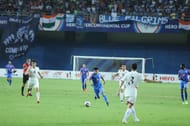Igor Stimac's experiments failed for the second time as India lost to North Korea in their second fixture of the Intercontinental Cup and dimmed their chances of defending the title. India, who were coming from a 2-4 defeat to Tajikistan only worsened the situation with a 2-5 scoreline against Korea DPR.
The Croatian manager started the match with nine changes to the lineup that faced Tajikistan. Sunil Chhetri and Amarjit Singh were the only players who kept their spot in the first XI. Sandesh Jhingan was back in the lineup, only to be substituted in the 37th minute with an injury. Attacking was below par in the first 45 minutes with Brandon Fernandes and Manvir Singh failing to create any notable moves on the wings. Jobby Justin's first start in the Indian jersey didn't gift him anything particular.
These flaws when followed by defensive errors, pulled the hosts into a horrible situation, conceding 3 goals in the first 30 minutes. Captain Jong Il Gwan opened the scoring and was backed by Sim Hyon Jin in the 16th minute. Jong Il Gwan's brace came when Amrinder Singh was sluggish in the Indian goal, and his header crept in off the post.
The Blue Tigers put in a better performance in the second half, scoring their first goal in the 50th minute through Lallinazuala Chhangte. However, defence did not change a bit, conceding for the fourth time in the 63rd minute. Sunil Chhetri's moment of brilliance in the 71st minute did not resolve the issues as India couldn't gather the game for the rest of the time. Ri Hyong Jin scored the fifth goal for the Koreans.
Conceding nine goals from two matches is a point of concern for the gaffer. Like the previous encounters, this too will be a lesson for Stimac, still trying out combinations on field. However, the talk still remains on whether the coach had to gamble with his lineup in a do-or-die match.
Now, we look at 3 reasons why India suffered a bad defeat to Korea DPR.
#3 Lack of discipline in the midfield

India's troubles against Korea started from their issues at the midfield. The team lacked creativity in the center leading to very few balls going forward. Manvir Singh and Brandon Fernandes were appointed on the wings, both playing out of position. This meant that India couldn't utilise their otherwise speedy wings, leaving Jobby Justin with no balls to finish.
In the central midfield, Amarjit Singh and Rowllin Borges were often wide open, offering huge space to the opponents. They failed to make interceptions and block down the Korean midfielders. Borges also found it difficult to keep up a combination with Jerry Lalrinzuala in the defence.
The Indian midfield was a complete failure throughout the first half, failing to keep possession or make any serious build-ups. However, the second half showed glimpses of a comeback with the substitutions of Udanta Singh, Lallianzuala Chhangte, Anirudh Thapa and Sahal Abdul Samad. The changes brought positivity and energy to the attacks but were not enough to match the Korean score.
One factor that haunted India for 90 minutes was the sloppy passing. The first half had too many of those leading to dangerous situations inside the box. Though the numbers were lower in the next 45 minutes, passes from blue shirts continued to reach the white shirts.
#2 Defensive woes not resolved

If India had defensive issues in the second half against Tajikistan, North Korea exploited it right from the beginning. A completely altered defence line couldn't solve any of Stimac's troubles. As desired, Sandesh Jhingan was back in action but paired with an out-of-form Subhasish Bose. The lapses made by inexperienced Narender Ghalot was repeated by Bose, playing his 16th international match.
The two full-backs Pritam Kotal and Jerry Lalrinzuala were constantly caught at fault, giving away possession cheaply. While Jerry contributed in attack in the second half, Pritam was a silent presence throughout the game. Jhingan was forced out in the first half following an injury and was replaced by Adil Khan. However, the Pune City defender couldn't help India from conceding again. Rahul Bheke's introduction in the second half was also not a success.
The issues that remained at Indian defence were many. All of the five goals conceded had errors from the defenders or goalkeeper. The centre-backs failed to guard spaces and the Korean attackers had far too much room to pick passes and even to take shots.
#1 Failure to deal with the opposition press

While the other two reasons are poor performances on the field, this one is a case of concern for the team. Even in the future, the Blue Tigers will struggle if the coach doesn't have an answer to this strategy from the oppositions.
North Korea, as expected, played a pressing game against India. One of the players followed the ball at all times, even when there was minimum scope of winning possession. This brought real trouble to the team, especially the doubtful defence. Being pressurized was the reason why India had to play too many back passes. Pritam Kotal was the most disturbed player in this system, forced to pass the ball to Amrinder very often. The second-choice goalkeeper also trembled at the sight of a Korean player charging in.
In the midfield, India had very minimal options with a White shirt always following. Manvir Singh and Brandon Fernandes could never really get past their markers, unsettling the attack. The turning point in the second half came from India's quicker wingers. The few good moves from India came out of the quick runs from Chhangte and Udanta. In central midfield, it was Sahal and Thapa with quick movements.
It was clear that the Blues lacked confidence to face the charging opponents. The case was similar against Tajikistan in the second half, which makes it an issue for Stimac to deal with.